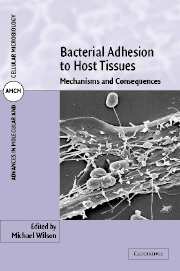Book contents
- Frontmatter
- Contents
- List of contributors
- Preface
- Part I Bacterial adhesins and adhesive structures
- 1 Surface protein adhesins of staphylococci
- 2 Mechanisms of utilization of host signalling molecules by respiratory mucosal pathogens
- 3 Adhesive surface structures of oral streptococci
- 4 Regulation and function of phase variation in Escherichia coli
- 5 Regulation of capsule expression
- 6 Role of pili in Haemophilus influenzae adherence, colonization and disease
- Part II Effect of adhesion on bacterial structure and function
- Part III Consequences of bacterial adhesion for the host
- Index
- Plate section
5 - Regulation of capsule expression
Published online by Cambridge University Press: 08 October 2009
- Frontmatter
- Contents
- List of contributors
- Preface
- Part I Bacterial adhesins and adhesive structures
- 1 Surface protein adhesins of staphylococci
- 2 Mechanisms of utilization of host signalling molecules by respiratory mucosal pathogens
- 3 Adhesive surface structures of oral streptococci
- 4 Regulation and function of phase variation in Escherichia coli
- 5 Regulation of capsule expression
- 6 Role of pili in Haemophilus influenzae adherence, colonization and disease
- Part II Effect of adhesion on bacterial structure and function
- Part III Consequences of bacterial adhesion for the host
- Index
- Plate section
Summary
BACTERIAL CAPSULES
The production of extracellular polysaccharide (EPS) molecules is a common feature of many bacteria (Whitfield and Valvano, 1993; Roberts, 1996). These molecules may be linked to the cell surface and organized into a discrete structure termed the capsule or, alternatively, may comprise an amorphous slime layer that is easily sloughed off from the cell surface. In essence, EPS provides a hydrated negatively charged gel that surrounds the bacterium and it is the physicochemical properties of this gel that account for the biological properties of bacterial capsules. A striking feature of bacterial capsular polysaccharides is their diversity, both in terms of component sugars and the glycosidic bond between repeating sugar residues. Even within a single bacterial species, there can be enormous structural diversity. For instance, in the case of Streptococcus pneumoniae there are in excess of 90 capsular serotypes. This diversity has important implications for the design of vaccine formulations that are based on capsular polysaccharides. Paradoxically, amongst this array of structural diversity, there are capsular polysaccharide molecules that are conserved across different bacterial species, such as the Escherichia coli K1 and Neisseria meningitidis serogroup B capsular polysaccharide (Jennings, 1990). Both the diversity of capsular polysaccharides and the conservation of certain polysaccharide structures across species barriers raise questions about the evolution of capsule gene clusters and the selective pressures that drive structural diversity.
For nearly 70 years, from the pioneering experiments of F. Griffith on the transformation of avirulent unencapsulated pneumococci to encapsulation and virulence (Griffith, 1928), it has been known that the expression of a capsule is an essential virulence factor.
Information
- Type
- Chapter
- Information
- Bacterial Adhesion to Host TissuesMechanisms and Consequences, pp. 115 - 138Publisher: Cambridge University PressPrint publication year: 2002
Accessibility standard: Unknown
Why this information is here
This section outlines the accessibility features of this content - including support for screen readers, full keyboard navigation and high-contrast display options. This may not be relevant for you.Accessibility Information
- 4
- Cited by
